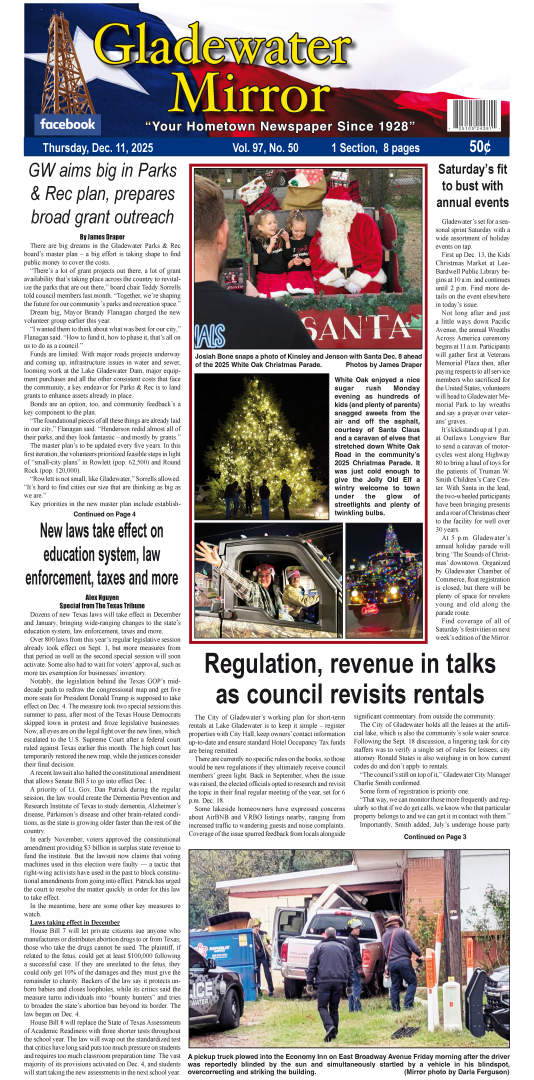By JAMES DRAPER |
Bring up ‘water supply’ in the wrong corner of Texas, and a person might get wrung out and hung out to dry.
It’s a tense issue where there are deficits and just as fraught in places of plenty: the tug-of-war between communities that ‘have’ and their ever-growing ‘have not’ neighbors near and far will get worse in the years and decades ahead without practical solutions.
 It’s why Texas Senator Bryan Hughes and his fellow legislators are pushing Senate Bill 7 for voters’ approval come November. Success means dedicating $20 billion to the problem during the next 20 years, split between new water sourcing and plugging leaks by revitalizing aging infrastructure.
It’s why Texas Senator Bryan Hughes and his fellow legislators are pushing Senate Bill 7 for voters’ approval come November. Success means dedicating $20 billion to the problem during the next 20 years, split between new water sourcing and plugging leaks by revitalizing aging infrastructure.
Failure continues the countdown toward a statewide water crisis by 2050.
Fortunately, the third-term East Texas Republican says, he’s not hearing much pushback on the proposal.
“We think this just makes sense,” Hughes said Monday.
There’s a litany of local problems, whether at the Marvin Nichols Reservoir near the Oklahoma border, bubbling up in the Cherokee County ground water dispute or, closer to home, roaring in the recent fight over piping Lake o’ the Pines water elsewhere.
“Those are the water concerns I’m hearing about. We’re working on each one of those issues, but at the same time we’re trying to find solutions so that Dallas and the Dallas suburbs can get water somewhere and don’t have to keep looking to us.”
That’s typically the crux of the issue, Hughes allowed: water, water everywhere except where the state’s growth is the most rapid, to the tune of a thousand new residents every day, statewide.
“In East Texas, we are blessed with lots of water,” Hughes said. “We have surface water, lakes, streams, rivers; we have ground water – really, underground water – the aquifers our wells tap into. Most of Texas does not.”
The way the state’s growing, there’s a pressing need for more supply. Local resources are enticing in deficit areas.
Straight talk: “From an East Texas perspective, we want to make sure that the state has plenty of sources,” he added, “and doesn’t have to look to us.
“How do I say this? We don’t mind sharing, but we don’t want them to take our water against our will.”
About 75 years back, the State of Texas and the U.S. Army Corps of Engineers developed new water supply across the Lone Star State.
“That’s what we’re living on today,” Hughes said. “If we don’t do something like that, our children and grandchildren will not be happy with us.”
(Notably, Lake Gladewater was built during the same time frame – to the same standards, but not as a Corps project.)
Supply’s already a problem. Barring real solutions, the clock’s ticking.
Already, Hughes cited, “There are nine cities in Texas to date that have said ‘No’ to an economic development opportunity, new manufacturing and new jobs, because ‘We don’t have the water.'”
Focusing on oversight and financing of water infrastructure under the jurisdiction of the Texas Water Development Board, SB7 targets ‘new’ water through desalinization as well as reclamation while devoting half the value to plugging the leaks in aging water systems statewide.
“We think of desalinization as something they do on the coast with Gulf water. But, we have so much underground ‘brackish’ water, saltwater, that can also be desalinated,” Hughes said. “While it’s an expensive process, it’s a whole lot cheaper than building reservoirs or taking water from East Texas. We’ll be desalinating that and using that for agriculture. That’s a big part of this.
“Also, where we have existing surface water, they’ll be working on using that. Other states – Arkansas, Louisiana – they have water they’re willing to sell. So, some of this money will be used to buy water from different states.”
While the major push is on developing new sources, concurrently funding infrastructure repairs to the tune of $500 million a year is essential.
“By fixing leaking pipes, we can also save a lot of water,” Hughes said.
It’s a common refrain in the City of Gladewater, and White Oak, too. Water systems here were installed in the 1930s, ’40s and ’50s, and plenty of that old hardware is still in the ground and breaking down, rupturing when the dirt’s wet, when it’s dry or if someone looks at the pipes the wrong way.
“It’s so expensive,” Hughes echoed, and local municipalities need the assistance SB7 will make available. That said, “To make an investment this size, the people of Texas need to have a say in it. It’ll be on the ballot.
“We hope voters do their homework and look at it. We’re optimistic voters will say ‘Yes.’ We think they’ll see this is a good solution.”









